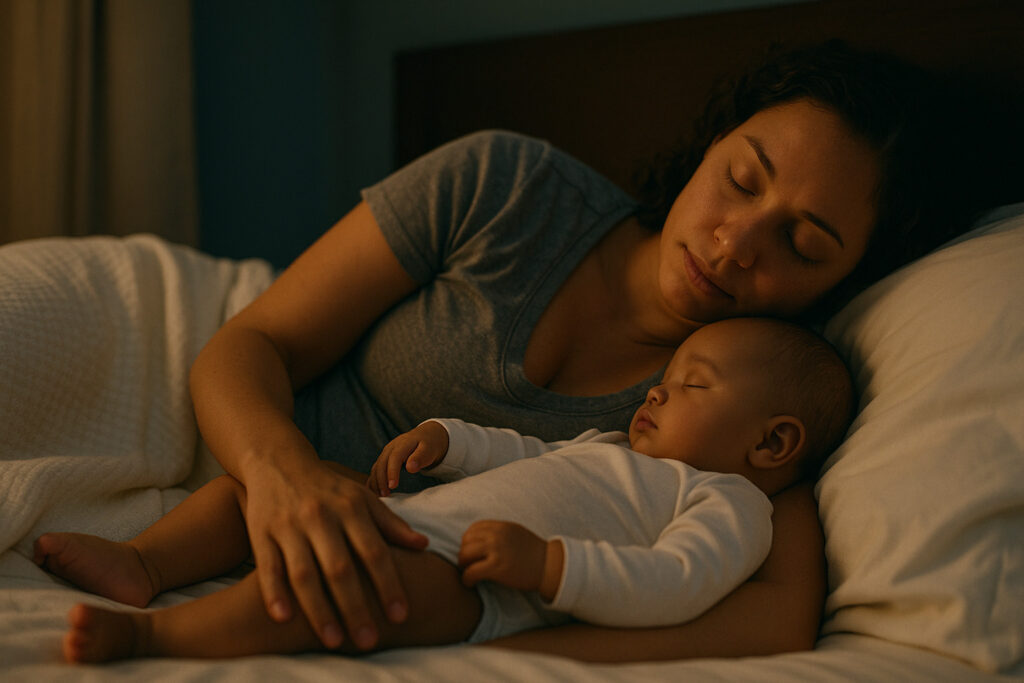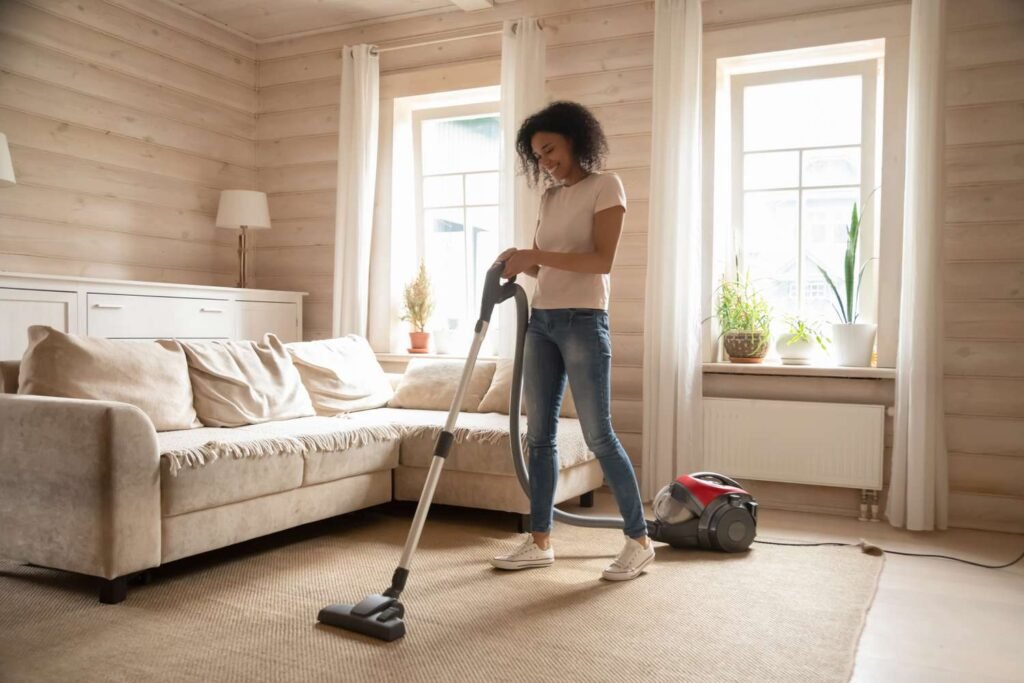Few parenting topics stir up as much debate as co-sleeping (bed-sharing). Co-sleeping means sleeping close to your baby – often in the same bed. In some cultures, it’s the norm for families to all snooze together, while in others, babies are expected to sleep in cribs from day one. Considering co-sleeping with your infant, weighing the benefits and practising it safely is essential. Let’s break down the potential advantages of co-sleeping and the precautions you should take.
Snuggle Benefits – Why Some Parents Love Co-Sleeping:
Nighttime Bonding and Security:
There’s something profoundly comforting about sleeping next to your baby. Hearing a parent’s breathing and feeling their warmth can create a sense of security for the baby. Many parents report that their infants sleep more soundly and cry less when co-sleeping because the baby can sense that mom or dad is right there. The close physical presence can strengthen the parent-infant bond and encourage a secure attachment. It’s not just touchy-feely talk – research by anthropologists like Dr. James McKenna suggests that when babies and parents sleep close, their sleep cycles even sync up, and babies may have more stable heart rates and breathing.
(Pretty amazing – biologically, we’re wired to be near our babies at night.)
Easier Nighttime Feeding (and More Sleep for Everyone):
If you’re breastfeeding, co-sleeping can be a game-changer. Instead of trekking across the house to a nursery multiple times a night, you have “room service” on hand. Many breastfeeding moms who bed-share feed in a side-lying position, dozing while the baby nurses. This often means the baby feeds more calmly and falls back asleep faster, and the parent can stay in a drowsy state rather than fully waking up. One study found that bed-sharing moms got total sleep time because they didn’t have to wake and soothe a crying baby as often fully – the baby rarely reached the full cry stage since the mom was right there to nurse. I vividly recall those early weeks with my daughter: I tried the crib at first, but I was a zombie from getting up every hour. Once I brought her into my bed (following safety guidelines), I could latch her on, and we drifted off. We woke up more rested and, frankly, happier. Co-sleeping can facilitate breastfeeding and make responding to the baby quickly at night easier.
Less Nighttime Anxiety (for Baby and Parents):
Newborns often startle themselves awake (the “Moro reflex”) and can get distressed in the dark alone. Co-sleeping babies might stir, sense a parent, and settle back without escalating. Likewise, many parents sleep with one ear open while listening to the baby’s breathing. Having the baby right next to you can reduce that middle-of-the-night anxiety where you check the crib every 5 minutes to see if they’re okay. (Co-sleeping parents often report they sleep better knowing their baby is safe beside them – no need to get up and check the bassinet every time there’s a peep.)
Cultural and Personal Preference:
In many parts of the world, co-sleeping while co-parenting is how families sleep. It can feel very natural to sleep snuggled with your infant if that matches your parenting instincts. And it’s okay if it’s also driven by desperation for sleep! Sometimes, the path to the most rest is just tucking the baby in with you. One mom friend said, “I wasn’t planning to co-sleep, but love and exhaustion won out – and honestly, I wouldn’t trade those sweet, cuddly mornings for anything.”
Safety First – How to Co-Sleep Safely:
You’ve probably also heard warnings about co-sleeping, specifically regarding SIDS (Sudden Infant Death Syndrome) or accidental suffocation. Improper bed-sharing can indeed be dangerous. However, many experts acknowledge that if parents are going to do it, it’s crucial to follow safe co-sleeping guidelines to minimize risks.
Here are important safety tips if you choose to co-sleep:
No impairment or smoking:
Parents who sleep with their baby must be non-smokers (smoking increases SIDS risk significantly) and not under the influence of alcohol, drugs, or any medication that makes you extra drowsy. You need to be alert enough, even in sleep, to be aware of the baby’s presence. If you’re exhausted (we know newborn parents are always tired, but we mean to the point of deep sleep deprivation where you might sleep like a rock), be extra cautious. In such cases, having the baby in a separate bassinet beside the bed might be safer for that night.
Safe Surface:
The bed should be firm and flat. No fluffy pillows or heavy blankets near the baby.
A firm mattress is key – no waterbeds, no saggy old mattresses that create pockets. Ideally, the baby sleeps on their back on your mattress (same as crib recommendations: back is safest). I dressed warmly and kept covers only at my waist so they never neared my baby. You can also use a special co-sleeping bassinet that attaches to your bed (giving baby their space but within arm’s reach).
Positioning:
A popular safe position is the “C-position” – the nursing parent forms a “C” shape around the baby: your body curled around with baby’s head near your breast, your lower arm above baby’s head, and knees bent below baby’s feet. This creates a little enclosure and makes it unlikely you’d roll onto the baby or that baby would scoot up or down. (Breastfeeding mothers naturally sleep this way, creating a protective cocoon.) Keep the baby on one side of you, not between two adults (to avoid overheating and more than one person who could accidentally roll). And, of course, make sure the baby can’t fall off the bed – use a guard rail or put the mattress on the floor if needed.
No siblings or pets in the bed:
However lovely it sounds to have the whole family pile in, other children or pets can inadvertently be unsafe bed-mates for a tiny infant. It’s recommended that the infant only bed-share with a parent who is aware of them. So if you have a toddler, you might make musical beds (another parent takes the toddler, while you co-sleep with the baby, for example).
Don’t Co-Sleep on a Couch or Chair:
This is a big no. Sofas and armchairs are high-risk for infant suffocation because babies can get wedged in cushions or between you and the back of the couch. If you’re feeding on the couch and feel sleepy, move to a bed or put your baby in a safe spot (like a bassinet) before you doze off.
Healthy, full-term babies only:
Co-sleeping is not advised for babies with specific vulnerabilities (premature, very low birth weight, or if they’re ill, etc.), as they might have more difficulty with safe bed-sharing. Those little ones are recommended to have their own safe sleeping space (like a bassinet) near you instead.
In summary, co-sleeping can offer wonderful benefits – closeness, easier feeding, possibly more sleep and less stress for everyone – but it must be done thoughtfully. Follow the “Safe Sleep 7” (a well-known checklist for safe bed-sharing: non-smoker, sober parent, breastfeeding, healthy baby, baby on back, safe surface, and adult-only bed). If all that is in place, many experts, including researchers like McKenna, agree that co-sleeping can be made as safe as crib sleeping. In fact, in cultures where safe co-sleeping is common, SIDS rates are often very low, suggesting that attentive bed-sharing can be safe.
Personal Perspective:
I ended up co-sleeping with both my kids after initially trying the crib. For us, it felt right. Waking up to their tiny snuffles and faces next to me are memories I cherish. With my son, I remember waking slightly when he’d wiggle, latching him on, and both of us dozing while he fed. We both slept better and he hardly ever truly “woke up” crying at night because I was right there to respond. In the mornings, I’d often find him staring at me, and the moment our eyes met, we’d both smile. That kind of bonding is priceless. That said, I was also hyper-aware of safety – I followed every guideline and ensured our sleep setup was as safe as possible.
In the end, the decision to co-sleep is personal. It’s not for everyone – some parents (or babies) just don’t sleep well in the same bed, and that’s okay too! Room-sharing (baby in a crib or bassinet in your room) is a great alternative that also confers safety and convenience benefits. But if you do choose co-sleeping, know that it can be done safely and can offer deep bonding and practical benefits. Trust your instincts, prioritize safety, and do what helps your family get the best rest. After all, a well-rested parent and baby are a happier parent and baby.










